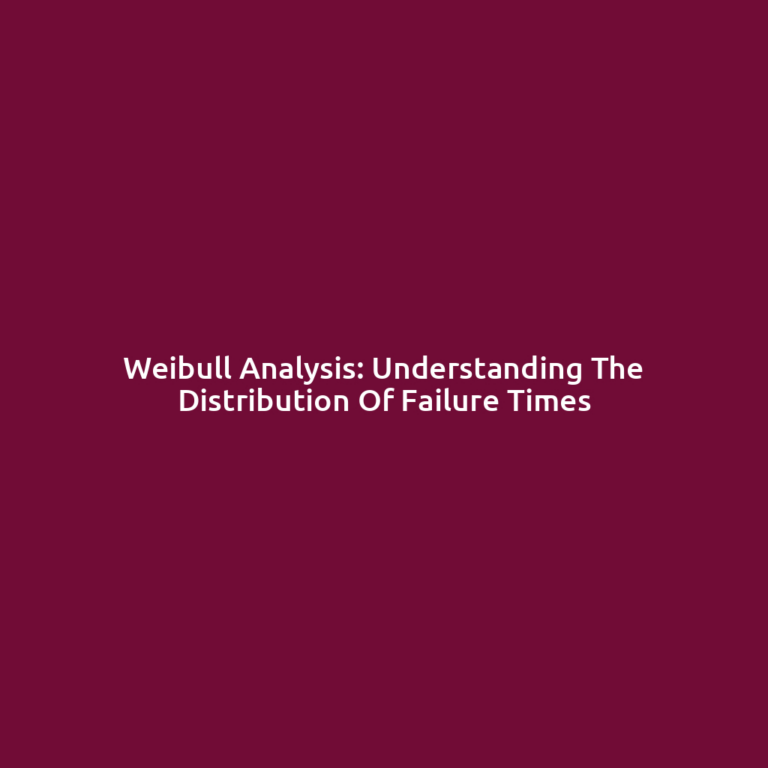Using Reliability Modeling to Improve Asset Performance
Asset management has transformed into a data-driven science and using reliability modeling to improve asset performance stands as a critical tool for companies striving to gain a competitive edge. In a world where every second of downtime can mean significant financial loss, the ability to predict, prevent and optimize asset functionality is more crucial than ever.
This is the primary reason why we will be looking at the topic “Using Reliability Modeling to Improve Asset Performance” Let’s dive into how reliability modeling works, its profound benefits and real-world applications that can revolutionize your asset performance strategy.
Reliability modeling is a systematic approach that evaluates the performance, failure probabilities and lifecycle of assets. It allows organizations to understand when, why and how their equipment might fail, helping to mitigate risks and extend asset longevity.
By integrating reliability modeling into your asset management framework, you can:
-
Pinpoint weak links in your systems.
-
Optimize maintenance schedules to minimize costs.
-
Enhance decision-making with actionable data.
But how does using reliability modeling to improve asset performance really work in practice?
Table of Contents
- 1 The Core Principles of Reliability Modeling
- 2 Why You Should Be Using Reliability Modeling to Improve Asset Performance
- 3 How to Implement Reliability Modeling in Your Organization
- 4 Applications of Reliability Modeling – Real Life Use
- 5 Metrics That Matter in Reliability Modeling
- 6 Challenges in Reliability Modeling and How to Overcome Them
- 7 Frequently Asked Questions About Using Reliability Modeling to Improve Asset Performance
The Core Principles of Reliability Modeling
Understanding the foundational principles of reliability modeling ensures you’re leveraging its full potential.
Let’s explore the key elements:
- 1. Failure Modes and Effects Analysis (FMEA)
At the heart of reliability modeling lies FMEA, a method for identifying possible points of failure. It evaluates the severity, occurrence and detectability of failures to prioritize preventive measures.
- 2. Reliability Block Diagrams (RBDs)
RBDs are visual representations of system reliability. They map out how components interact, allowing you to see the cascading effects of failures.
- 3. Probabilistic Risk Assessment (PRA)
PRA introduces a layer of quantitative analysis, enabling predictions about failure rates based on historical data. This makes it possible to implement data-backed strategies for improved asset performance.
Why You Should Be Using Reliability Modeling to Improve Asset Performance
The benefits of reliability modeling stretch beyond reducing downtime and this is what we will be emphasizing on this sections.
Here’s why it’s a game-changer:
Cost-Effective Maintenance
Reactive maintenance is a budget buster. Waiting for something to break before fixing it leads to unnecessary expenses. Reliability modeling empowers you to transition to predictive maintenance, reducing costs and eliminating unnecessary repairs.
Improved Equipment Availability
Downtime is the enemy of productivity. Reliability modeling identifies potential failure points before they happen, ensuring that your assets remain operational when you need them most.
Extended Asset Lifespan
Overuse or neglect often shortens the lifespan of assets. Using reliability modeling to improve asset performance allows you to strike the perfect balance, ensuring longevity without compromising functionality.
Enhanced Safety
In industries like oil and gas or manufacturing, asset failure can pose significant safety risks. Reliability modeling mitigates these risks by predicting and addressing vulnerabilities early.
How to Implement Reliability Modeling in Your Organization
The journey to using reliability modeling to improve asset performance begins with the right strategy.
Here’s a step-by-step process:
1. Gather and Analyze Historical Data
The backbone of reliability modeling is accurate data. Gather historical data on asset performance, maintenance schedules and failures to create a robust foundation.
2. Select the Right Tools and Software
Advanced software solutions, like Asset Performance Management (APM) systems, can streamline reliability modeling. They offer intuitive interfaces and integrate seamlessly with existing data systems.
3. Build Predictive Models
Use statistical techniques and machine learning algorithms to create predictive models tailored to your assets. These models help forecast failures and inform proactive strategies.
4. Regularly Update Your Models
Reliability modeling is not a one-and-done effort. Update your models regularly with new data to ensure they remain accurate and relevant.
5. Train Your Team
Your team’s expertise is just as important as your tools. Provide training to ensure they understand and can effectively use reliability modeling in daily operations.
Applications of Reliability Modeling – Real Life Use
Using reliability modeling to improve asset performance isn’t theoretical – it’s already transforming industries worldwide. Let’s look at some examples:
Oil and Gas Industry
With high stakes and complex systems, oil and gas companies rely heavily on reliability modeling. From pipeline integrity to offshore drilling equipment, predictive analytics reduce the risk of catastrophic failures.
Manufacturing
In manufacturing, unplanned downtime can cripple operations. Reliability modeling helps optimize production schedules, ensuring seamless operations and higher output quality.
Transportation
Railways and airlines use reliability modeling to keep fleets operational and safe. By predicting component failures, these industries maintain stringent schedules and ensure passenger safety.
Metrics That Matter in Reliability Modeling
Measuring success is key when using reliability modeling to improve asset performance. Here are the essential metrics to track:
-
Mean Time Between Failures (MTBF): Measures average time between failures, indicating overall reliability.
-
Mean Time to Repair (MTTR): Tracks how quickly repairs are performed, highlighting efficiency.
-
Failure Rate: Provides insights into the likelihood of asset failure over time.
-
Availability: Measures how often an asset is available for use versus downtime.
Challenges in Reliability Modeling and How to Overcome Them
While the advantages are immense, there are challenges you might face when implementing reliability modeling:
Data Gaps
Inaccurate or incomplete data can undermine the entire modeling process. The solution? Invest in IoT sensors and automated data collection systems.
Resistance to Change
Introducing new processes often meets resistance. Overcome this by demonstrating the clear ROI of reliability modeling through small, impactful pilot projects.
Complexity of Implementation
Reliability modeling can feel overwhelming. Partnering with experts or consultants can ease the transition and ensure proper setup.
By understanding its principles, implementing robust strategies and leveraging cutting-edge tools, you can unlock unparalleled performance and reliability in your assets. Start small, build expertise and watch as your organization reaps the benefits of this transformative approach.
Want to revolutionize your asset management strategy? Begin your journey into reliability modeling now and pave the way for a future of unparalleled efficiency and success!
Frequently Asked Questions About Using Reliability Modeling to Improve Asset Performance
1. What is reliability modeling in asset management?
Reliability modeling is a structured approach to understanding and predicting the performance and potential failures of assets. It uses data and statistical tools to optimize maintenance, extend asset lifespan and minimize downtime.
2. How does reliability modeling improve asset performance?
Reliability modeling improves asset performance by identifying potential failure points, optimizing maintenance schedules and enabling predictive strategies. This leads to reduced downtime, cost savings and enhanced operational efficiency.
3. What industries benefit the most from reliability modeling?
Industries like oil and gas, manufacturing, transportation, energy and healthcare benefit significantly from reliability modeling due to their reliance on high-value, mission-critical assets.
4. What tools are commonly used for reliability modeling?
Popular tools include Asset Performance Management (APM) software, Failure Modes and Effects Analysis (FMEA) frameworks and advanced data analytics platforms incorporating machine learning and AI.
5. Can small businesses implement reliability modeling?
Yes, small businesses can implement reliability modeling. While large-scale operations may use advanced software, smaller organizations can leverage simpler tools and focus on specific assets for high-impact results.
6. What data is required for effective reliability modeling?
Effective reliability modeling requires data on asset performance, maintenance history, failure rates, operating conditions and lifecycle costs. IoT sensors and automated systems can help collect this data.
7. How often should reliability models be updated?
Reliability models should be updated regularly, ideally whenever new data becomes available. Regular updates ensure the models remain accurate and relevant to current operating conditions.
8. What are the challenges of implementing reliability modeling?
Challenges include data gaps, resistance to change and the complexity of setup. Addressing these with proper tools, training and expert support can ensure a smoother implementation.
9. Is reliability modeling only for predictive maintenance?
No, reliability modeling goes beyond predictive maintenance. It also supports decision-making in areas like asset design, resource allocation and risk mitigation.
10. How does reliability modeling integrate with emerging technologies?
Reliability modeling integrates seamlessly with AI, machine learning and digital twin technologies. These innovations enhance predictive capabilities and enable advanced simulations for better asset management.
Weibull Analysis: Understanding the Distribution of Failure Times





2 Comments